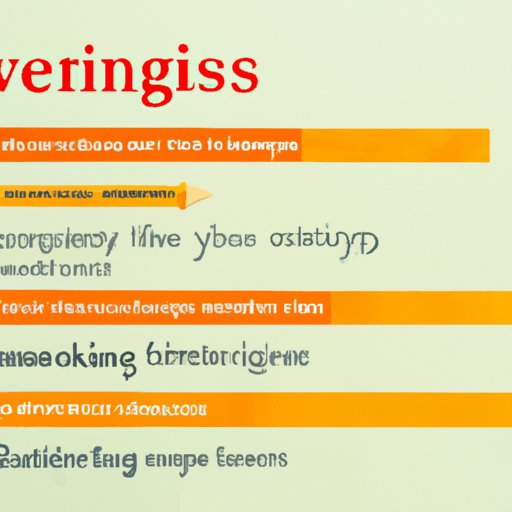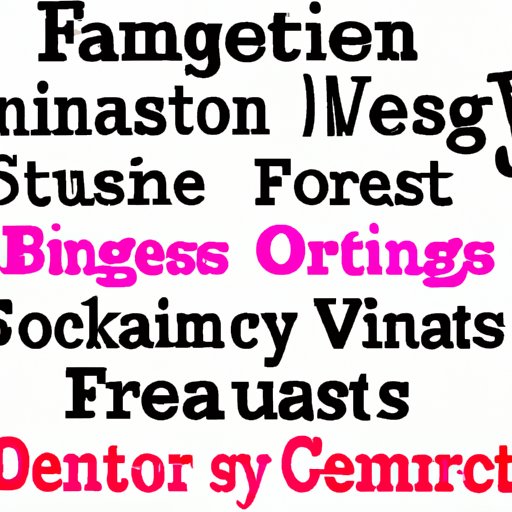Introduction
Writing genres are categories of writing that have distinct characteristics and conventions. They are used to differentiate between different types of written works. The purpose of writing genres is to provide readers with a way to identify and organize written works according to their content, subject matter, and style. Knowing the different types of writing genres can help writers better understand the audience they’re trying to reach and the type of work they’d like to create.
Overview of Writing Genres: What They Are and How to Use Them
Writing genres can be divided into two main categories: fiction and nonfiction. Fiction includes stories, novels, plays, and other works of imaginative literature. Nonfiction includes biographies, autobiographies, essays, and other works of factual information. Each genre has its own set of conventions and characteristics that define it.
The benefits of using writing genres are numerous. They help to organize and structure written works, making them easier to read. They also make it easier for readers to find the type of work they’re looking for. Additionally, using writing genres allows writers to hone their craft by learning the conventions and characteristics of each genre.
Examples of writing genres include poetry, drama, mystery, science fiction, romance, horror, fantasy, and more. Each genre has its own unique characteristics and conventions that make it distinct from other genres. For example, poetry is typically written in short stanzas, while dramas are often composed of several acts.

A Guide to Writing Genres: How to Choose the Right One for Your Story
When selecting a writing genre, it’s important to consider your audience. Think about who you want to reach with your writing and what type of work would appeal to them. For instance, if you’re writing a children’s book, you’ll want to choose a genre that appeals to young readers. On the other hand, if you’re writing an adult novel, you’ll want to select a genre that resonates with adults.
It’s also important to think about your theme when selecting a writing genre. Consider the topic you’re exploring and the message you’re trying to convey. Different genres have different conventions and characteristics that may or may not lend themselves to your particular topic or theme.
Finally, it’s a good idea to research popular genres to get an idea of what other writers are doing. Reading books in different genres can help you gain insight into the conventions and characteristics of each genre. This will give you an understanding of what makes a particular genre unique and how to use it effectively.
Exploring Different Writing Genres: Fiction, Nonfiction, and More
Fiction writing is a genre of writing that involves creating stories, characters, and settings that are imaginary or partially based on real life. It includes novels, short stories, plays, and screenplays. Common elements of fiction writing include plot, character development, setting, and dialogue.
Nonfiction writing is a genre of writing that deals with facts and real-life events. It includes biographies, autobiographies, essays, and other works of factual information. Common elements of nonfiction writing include research, accuracy, and objectivity.
Other writing genres include poetry, drama, mystery, science fiction, romance, horror, fantasy, and more. Each genre has its own unique conventions and characteristics that make it distinct from other genres. For example, poetry is typically written in short stanzas, while dramas are often composed of several acts.

The Types of Writing Genres: What You Need to Know
Drama is a genre of writing that focuses on interpersonal relationships and conflict. It often consists of several acts, with each act focusing on a different aspect of the story. Common elements of drama include character development, dialogue, and action.
Comedy is a genre of writing that focuses on humor and wit. It often involves exaggeration and satire. Common elements of comedy include wordplay, puns, and irony.
Romance is a genre of writing that focuses on love and relationships. It often involves a conflict between two characters and a happy ending. Common elements of romance include passionate scenes, dramatic tension, and heartfelt dialogue.
Writing Genre 101: A Beginner’s Guide to Differentiating Between Genres
Differentiating between writing genres can be difficult, especially for beginning writers. To help, here are some steps to identifying writing genres:
1. Identify the tone and mood of the work. Is it lighthearted or serious? Is it humorous or somber?
2. Look at the structure and formatting of the work. Does it have multiple acts, chapters, or stanzas?
3. Examine the characters and plot. Are the characters realistic or exaggerated? Is the plot linear or episodic?
4. Consider the themes and topics explored. Are they serious or comedic? Do they focus on romance or suspense?
Tips for choosing the right genre include reading books in different genres, researching popular genres, and considering your audience and theme. Knowing the conventions and characteristics of each genre will help you make an informed decision.

Writing Genres: An Introduction to Understanding Different Types of Writing
Each genre of writing has its own description and characteristics. Poetry, for example, is typically written in short stanzas and focuses on imagery and emotion. Drama, on the other hand, is typically composed of several acts and focuses on interpersonal relationships and conflict. Romance is another genre that focuses on love and relationships, often involving a conflict between two characters and a happy ending.
When writing in different genres, it’s important to keep in mind the conventions and characteristics of that genre. For example, if you’re writing a poem, you’ll want to focus on imagery and emotion. If you’re writing a drama, you’ll want to focus on character development, dialogue, and action. And if you’re writing a romance, you’ll want to focus on passionate scenes, dramatic tension, and heartfelt dialogue.
Conclusion
Writing genres are categories of writing that have distinct characteristics and conventions. They are used to differentiate between different types of written works and provide readers with a way to identify and organize written works according to their content, subject matter, and style. Knowing the different types of writing genres can help writers better understand the audience they’re trying to reach and the type of work they’d like to create.
When selecting a writing genre, it’s important to consider your audience, think about your theme, and research popular genres. Differentiating between writing genres can be difficult, but knowing the conventions and characteristics of each genre will help you make an informed decision.
In conclusion, writing genres are an essential part of writing and can help writers hone their craft. Understanding the different types of writing genres and how to use them will enable writers to create works that resonate with their audience.
(Note: Is this article not meeting your expectations? Do you have knowledge or insights to share? Unlock new opportunities and expand your reach by joining our authors team. Click Registration to join us and share your expertise with our readers.)
